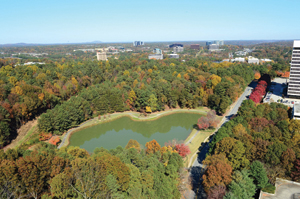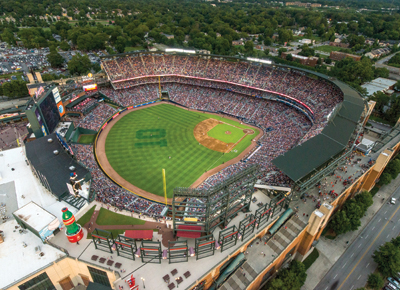The Atlanta Braves’ surprising plans to build a new stadium in Cobb County are in large part about the opportunity to create a large-scale, mixed-use development surrounding the ballpark and not the facility itself.
Such ancillary projects have quickly become important in baseball, with recent examples including the St. Louis Cardinals’ long-delayed Ballpark Village in St. Louis and announcements of the San Francisco Giants’ planned Mission Rock development near AT&T Park and the involvement of Washington Nationals owner Ted Lerner in real estate developments around Nationals Park.
 |
The Cobb County site where the club plans to build.
Photo by: BYRON E. SMALL
|
The Braves have studied the Ballpark Village project as well as mixed-use developments next to MLB parks in San Diego and Denver, said Derek Schiller, the team’s executive vice president of sales and marketing.
The Braves’ Cobb County development will incorporate about 1 million total square feet of residential, office space, retail, restaurants, green space and a hotel. The team has not disclosed costs.
Also part of the plan is a small amphitheater that takes advantage of
INSIDE THE BRAVES’
BALLPARK PLANS
Here is a sneak peek into what the new Atlanta Braves ballpark could look like, based on information from team officials familiar with the project.
■ The Braves said the total project cost is $672 million, covering soft costs such as land acquisition and infrastructure improvements. The team has not released the hard costs for stadium construction.
■ The proposed 41,500 seats represent 8,000 fewer than at Turner Field, the Braves’ 17-year-old ballpark. The team’s intent is to develop a smaller footprint with more intimate views and unique spaces.
■ The planned 30 to 40 suites place it among the MLB parks with the fewest skyboxes, in a range with Kauffman Stadium (25) and Marlins Park (39). Turner Field opened in 1997 with 63 suites, a number reduced to the mid-50s as the market shifted for premium seats.
■ Overall, 10 percent of the new park’s total seats will be in premium locations, many tied to clubs and all-inclusive food and drink packages. The number falls in the range of suites and club seats at newer MLB venues, according to research compiled by CSL International. At Turner Field, 1 percent of the park’s 49,583 seats are premium, excluding suites.
■ About 30,000 parking spaces already are within walking distance of the new ballpark site, which is situated 12 miles northwest of Turner Field. Additional spaces will come as part of the new development.
■ The Braves expect up to 1 million square feet of office, retail, hotel and residential development to open at the same time their new ballpark opens in 2017.
■ The Braves are using sports architect HKS as a consultant. The same firm designed Coolray Field, home of the Gwinnett Braves, their Class AAA club; new parks for the MLB Rangers and Brewers; renovations for the parks of the Dodgers and White Sox; and some spring training facilities.
— Don Muret
the natural undulation of the ballpark site. The club intends to name a development partner to manage the mixed-use work early next year, Schiller said.
“Not only is this project going to have that mixed-use development, but we intend for a substantial portion of that to be open in 2017 in concert with the arrival of the ballpark itself,” Schiller said.
It’s a bold statement, considering that other teams, namely the Cardinals, said the same thing only to see those projects take years to develop after sports venues open their doors. Ballpark Village is still coming out of the ground eight seasons after new Busch Stadium opened.
Despite the misses that have come with the hits, though, teams keep pitching these deals, and there’s a key reason why: Mixed-use developments can spin off additional dollars not subject to league revenue sharing. They also help create a daylong destination for fans attending the games.
Braves executives said for at least the immediate future, the club’s operating budget and payroll will be firewalled from the real estate efforts.
“Our baseball operation needs to operate on the stadium itself and related revenue,” Schiller said. “The mixed-use development, not now anyway, is not integrated with the team from a business standpoint. We’ve run the team as a disciplined operation and that does not change with the new stadium.”
The Cardinals have echoed similar sentiments with Ballpark Village, saying its large upfront investment with partner Cordish Co. has yet to be recouped, according to Cardinals President Bill DeWitt III.
Related story: Braves say AAA team will remain in Gwinnett Co.
The project’s $100 million first phase, including restaurants, a club hall of fame and museum, and concert and event space, will open next spring. “I’m sure [the Braves] will be looking hard at how we do next year,” DeWitt said.
 |
The Braves talked to Atlanta about redeveloping property near Turner Field.
Photo by: GETTY IMAGES
|
Last week’s news in Atlanta came after the Braves had talks with city officials about investing in a major renovation of Turner Field and redeveloping property outside the stadium, which sits near low-income neighborhoods. What became obvious, though, was the Braves felt they would be better served by moving elsewhere instead of spending $200 million-plus to upgrade their current facility, more than half of which would be spent to replace ballpark infrastructure, Schiller said.
The Braves struck a deal with Cobb County officials and settled on a 60-acre greenfield site in an unincorporated part of town that still has a city of Atlanta address. It runs counter to a quarter-century ballpark development trend toward urban locales. But club officials insisted they saw the move as not necessarily the beginning of a bigger trend, even as numerous facilities beyond Turner Field built in the mid-1990s are approaching the end of their lease terms.
“I don’t think there’s a broader statement with regard to stadium location or anything like that,” Schiller said. “This is very specific to Greater Atlanta and the dynamics of Atlanta.”
In San Diego, investment in the Gaslamp District development around Petco Park has grown to $4 billion, nine years after two hotels and four residential towers opened at the same time the stadium did in 2004, said Erik Judson, a principal with JMI Sports involved with the Padres’ project.
“Ours was more organic, but the ballpark changed the whole dynamic for people investing in the area,” Judson said.
The development has been successful because of its location in the urban core of San Diego. Turner Field, by comparison, sits at the edge of downtown Atlanta, disconnected from the heart of the city encompassing the Georgia Dome and Philips Arena, Judson said.
“It’s not like they had an urban park before, even though it’s close to downtown,” he said. “They must feel the draw of significant economic development and new development is much greater [in Cobb County] than around Turner Field.”





